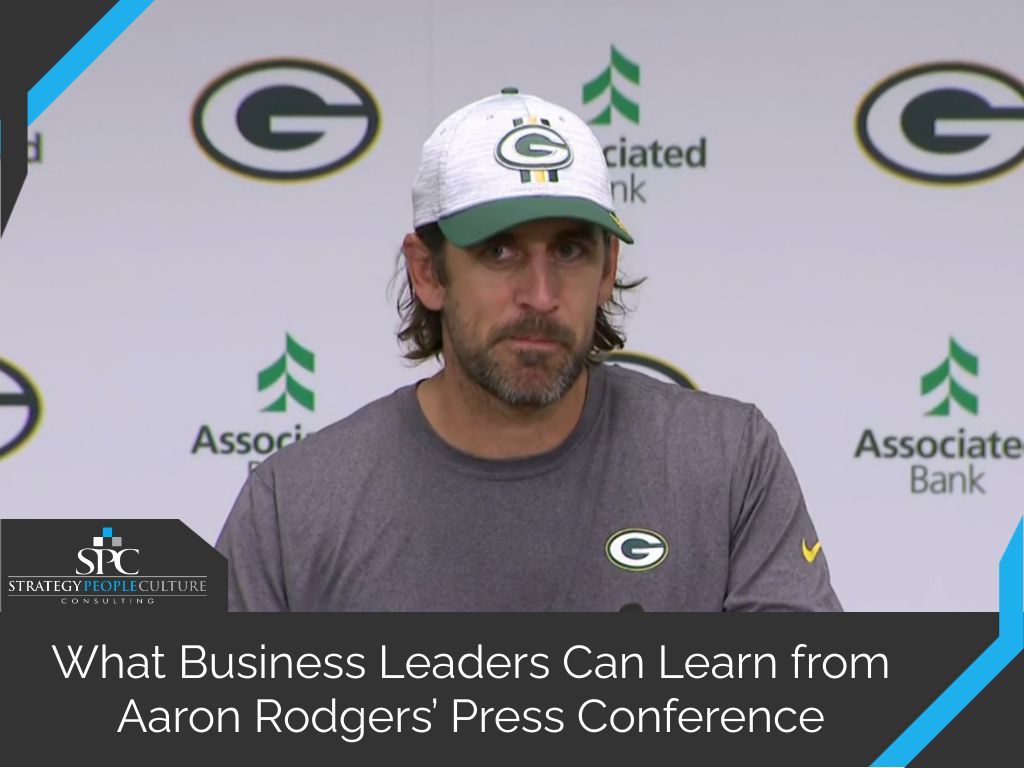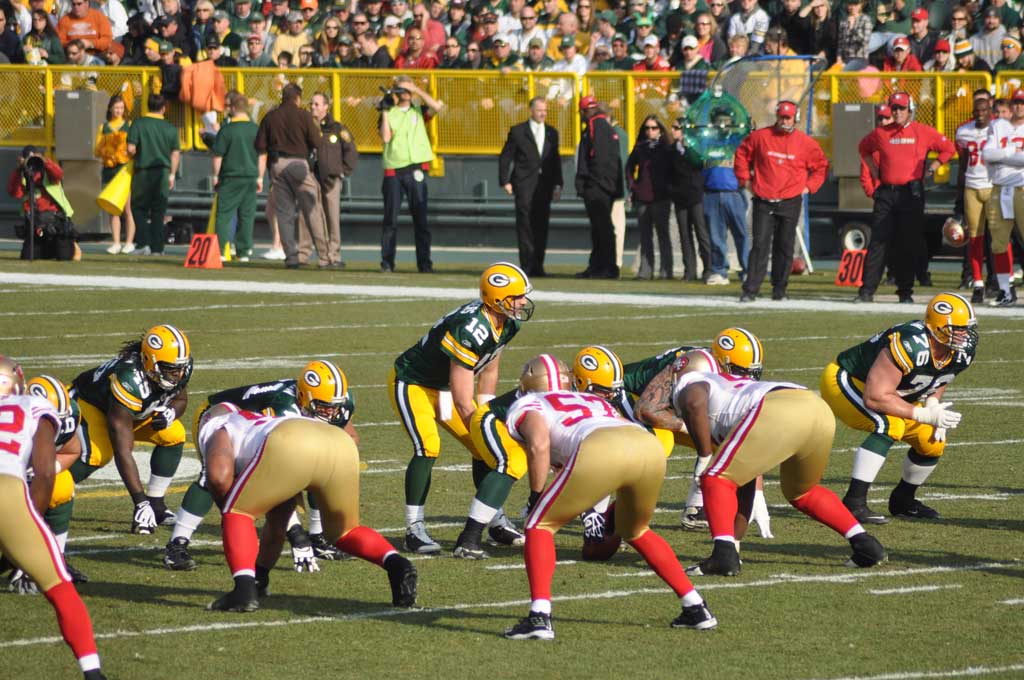What Business Leaders Can Learn from Aaron Rodgers’ Press Conference

The July 28th Aaron Rodgers press conference caused an uproar throughout the NFL’s massive fan base. But the issue goes far deeper than the speech.
The football world has been dominated by Aaron Rodgers-Green Bay Packers headlines since the 2021 NFL draft. Stories began to surface that the Green Bay Packers star quarterback was unhappy with the organization and “had no plans to return to the team in 2021.”
This rift certainly didn’t fall out of the sky. Tensions between the reigning league MVP (Most Valuable Player) and the Packers have been rising steadily over the past couple of years.
Two notable instances were in 2018 where the Packers front office fired the team’s quarterback coach without consulting Rodgers (who was the undisputed quarterback of the team), and of course, drafting quarterback Jordan Love in the first round of the 2020 NFL draft.
In many ways, the 2021 draft day headlines story was a boiling point between the two parties – and the Aaron Rodgers press conference was the scalding water spilling all over the stovetop.
The Press Conference
In late July, Aaron Rodgers put Packer fans around the world at ease by showing up to training camp and returning to the team for the 2021 season. However, the relationship between Rodgers and the Packers organization wasn’t exactly peaches and cream.
On July 28th, the star quarterback gave a 30+ minute press conference going into detail about his frustrations with the front office over the past several years. In a nutshell, Rodgers expressed his desire to be included in conversations that directly impact the success of the team, how outgoing players are treated, and decisions in free agency.
This press conference tore the veil off any unknowns regarding the Rodgers-Packers tension – after years of speculation.
The Conundrum
The Aaron Rodgers press conference confirmed two things:
On one hand, Aaron Rodgers believes he has earned a voice in the team’s organizational decisions that impact the ability to succeed. On the other, the Packers front office wanted to keep the chain of command as is; leave the decision making to the dedicated decision-makers (the general manager, executive officer, etc.)
Unfortunately, there is no right answer here, as both sides make valid points. The one absolute missing answer to this was the lack of communication and expectation setting, in other words, failed leadership.
In Green Bay, it’s clear there are two leadership parties: The elite talent of Aaron Rodgers on the field and the front office off the field.
Harmony between these two parties is crucial. Agreement won’t always be reasonable, however, end alignment is a key agreement to sound operational effectiveness.
This goes for all businesses; there needs to be a healthy level of give and take between top employees and executives. At the end of the day, good leadership is about understanding the ripple effect of both actions and inactions.
In the Green Bay-Rodgers fiasco, a great deal of this tension could have been minimized (if not avoided altogether) by both sides taking a step back to critically examine the situation. What did each side do right? What did each side do wrong? How can they find common ground?
Looking at the big picture is extremely tough without a skilled 3rd party – whether it’s an NFL organization or a small business. This is why executive/leadership coaching exists.
An executive coach is removed from the hierarchy, egos, and culture to help all parties approach the situation objectively and challenge individual thinking to better decision making. The executive coach will help everyone understand the effects of their actions, inactions, and create a more empathetic mindset to how these relationships are managed.
But still, there is a line of questioning to be asked in the Green Bay-Aaron Rodgers saga.
Is One Player Above the Team?
The simple answer is no. But there’s more to it than that.

There is no doubt in anyone’s mind that talent is crucial to any organization’s success. This would be an understatement when talking about Aaron Rodgers’ impact on the Green Bay Packers over the last decade. But no single individual is ever above the organization – including both leaders and employees.
The Rodgers-Green Bay situation is a clear indication of a lapse in leadership. Successful leaders can remove their emotions and think objectively to understand each other – as well as the direct impact of their actions.
Regardless of role or status, it’s important to keep in mind that everyone is replaceable, even leaders. The purpose of executive and leadership coaching is to make leaders more effective thinkers in understanding the internal impact of their role on the rest of the organization.
Should an Employee Be Included in Important Business Decisions?

In the Aaron Rodgers press conference, Rodgers made it clear he wanted to be involved in the decision-making process about how certain talent is managed – but was effectively shunned.
It’s no secret the American football universe is divided on this.
Some would say the Packers front office is demonstrating good leadership in that organizations cannot let the inmates run the asylum. Others would say the results Aaron Rodgers has produced in his long tenure with Green Bay has earned him the right to sit at the table when business decisions are being made.
These positions represent two schools of thought.
One – hierarchy within organizations exists for a reason. Employees are there to perform the duties of their job descriptions. Leaders are there to make those big decisions for the good of the organization. Overstepping these bounds can create chaos.
Two, if an employee’s insight could truthfully improve the end result, is it in the best interest of the organization to overlook lanes and roles? If so, should they consider every employee’s insight? Where do they draw the line to avoid blurring these lines?
Leaders in an organization have the layered task of finding the perfect balance here – and it’s certainly not an easy one. To reiterate, talented employees are crucial to an organization’s success. But talent oftentimes comes with an ego. Leadership must be able to manage these egos, create an environment of mutual respect, and find a common ground to collaborate for the good of the organization.
In short, executive leadership requires an intrinsic ability to empathize with employees – while maintaining the organizational hierarchy. Truth be told, even the biggest and brightest leaders struggle with this – the Rodgers-Green Bay situation is clear proof.
Executive coaches help leaders find the middle ground to minimize tension and keep order within the organization.
What it All Means – for Green Bay and Beyond

I’ve been working in executive leadership for a long time. My take is that the Rodgers-Green Bay situation could have been handled better on both sides. Neither party is “right” or “wrong” here. The issue started with the Green Bay front office struggling to understand their employees – and employees struggling to understand executives.
Moreover, the Aaron Rodgers press conference showed what happens when this dysfunction festers over several years.
An argument to be made here examines Tom Brady.

By all objective standards, Rodgers had significantly more talent coming out of college than Brady. Even to this day, many would view Rodgers as the better pure talent. But Brady’s success throughout his career is second to none.
This begs the question: is Tom Brady’s success a testament to organizational harmony between leaders on the field and leaders in the front office? There is likely some truth to this.
Success in ANY business – regardless of size or stature – starts on the inside. If it’s clear that leadership has a habit of failing to understand their employees, there will be trouble down the line. Unchecked, unmitigated tension between leaders and employees will eventually boil over into the end result.
Leadership is all about understanding the cause & effect of every action. An executive coach specializes in helping leaders look at their actions through a different lens. The goal is to assess the ripple effect, pinpoint the seeds of tension, and develop a healthy approach to manage relationships.
The Wrap
Whether you are a huge corporation, an NFL team, or a tiny startup, you will elevate your potential success with good leadership. The Aaron Rodgers press conference has shown us what can happen when there is a lack of empathy between executives and employees. More importantly, it made us think more critically about managing relationships within an organization.
Executive coaching can do wonders to help front-office leaders with self-awareness, clarifying organizational goals, and effectively tapping into the potential of others within the organization.
When looking at talent on the field, leadership coaching can be critical in finding harmony between their role, how their insight can impact the organization, and managing issues related to hierarchy. In this situation, a more calculated approach to the player-front office tension could have done a lot to create a better end result.
I started Strategy People Culture to help current and future leaders manage these issues.
How important are the relationships within your business?
Do you want to be a more effective leader?
Please reach out to us online or call us at (833) ROCK SPC.
We can talk about the NFL and leadership all day. But we’d love to connect and help you and your business create better outcomes – both internally and externally.
Sources:
https://www.nfl.com/news/aaron-rodgers-packers-training-camp-press-conference-retirement
